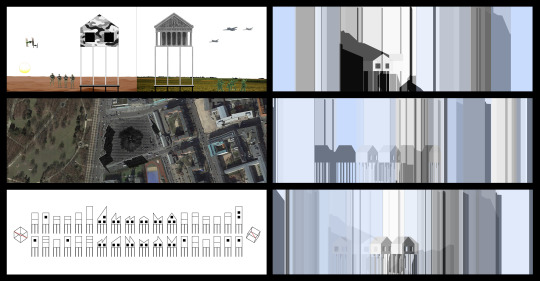#ArchitectureAndScience
Explore tagged Tumblr posts
Text

Intersections of Science, History, and Philosophy in Architectural Discourse
In the realm of architecture, the confluence of scientific principles, historical contexts, and philosophical inquiries offers a rich tapestry for critical analysis. The data provided presents a compelling exploration of these intersections, inviting us to delve deeper into the multifaceted nature of architectural discourse.
At the heart of the discussion lies the concept of the magic angle, a precisely defined angle with profound implications in scientific fields such as solid-state NMR spectroscopy and magnetic resonance imaging. From an architectural standpoint, the magic angle prompts reflection on the nuanced relationship between form and function. Just as scientific interactions depend on precise alignments, architectural elements must harmonize to create spatial experiences that transcend the ordinary.
Parallel to this scientific inquiry is the exploration of the Primitive Hut, a foundational concept in architectural theory that posits architecture's origins in the fundamental relationship between humans and their natural environment. This notion challenges architects to create spaces that seamlessly integrate with their surroundings, embodying what is natural and intrinsic. The Primitive Hut serves as a reminder of architecture's roots and the enduring relevance of contextual sensitivity and sustainability in design practice.
The discourse also delves into architectural responses to historical events, particularly wars. From restorationist approaches seeking to recreate pre-war conditions to innovative styles reflecting the need for progress, architects have grappled with reconciling the past with the imperatives of the present. This dynamic evolution reflects architecture's resilience and adaptability as a discipline shaped by socio-historical forces.
Central to the discussion is the work of Bruno Minardi, whose reinterpretation of the Primitive Hut in pieces like "Le bateau ivre" exemplifies architecture's transformative power. By situating the primitive hut concept within contemporary contexts, Minardi challenges traditional narratives and invites reflection on architecture's role in shaping perceptions and narratives. The incorporation of the magic angle into architectural form further blurs the boundaries between science and architecture, opening new avenues for exploration and expression.
Moreover, the mention of axonometric drawing and its inherent blind spot leading to the fourth dimension adds a layer of complexity to architectural representation. Architects confront the challenge of translating multidimensional concepts into two-dimensional drawings, highlighting the need for innovative visualization techniques.
In conclusion, the data underscores architecture's multifaceted nature, encompassing scientific inquiry, historical context, and philosophical discourse. By engaging with these intersecting realms, architects have the opportunity to transcend the ordinary and contribute to the collective human experience through the built environment. As critical observers, we must continue to explore these intersections and interrogate the implications for architecture and society at large.
#ArchitecturalIntersections#MagicAngle#PrimitiveHut#BrunoMinardi#ArchitecturalTheory#HistoricalContext#PhilosophicalInquiry#Sustainability#Innovation#AxonometricDrawing#BuiltEnvironment#ArchitectureAndScience#ArchitectureAndHistory#ArchitectureAndPhilosophy#SpatialExperiences#InterdisciplinaryApproach#architecture#berlin#area#london#acme#chicago#puzzle#edwin lutyens#massimoscolari#oma#bruno minardi
0 notes